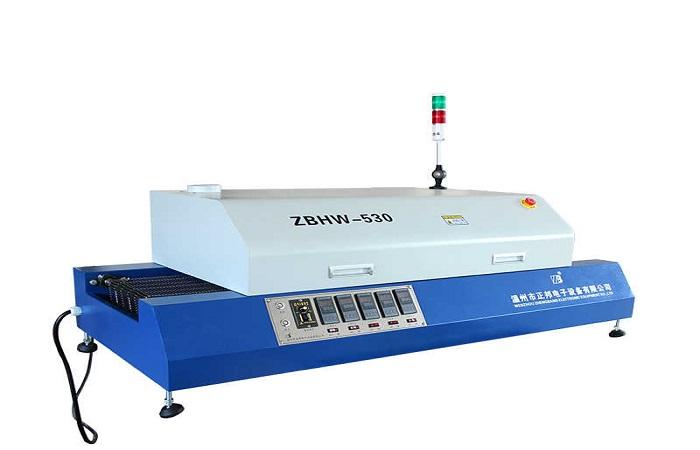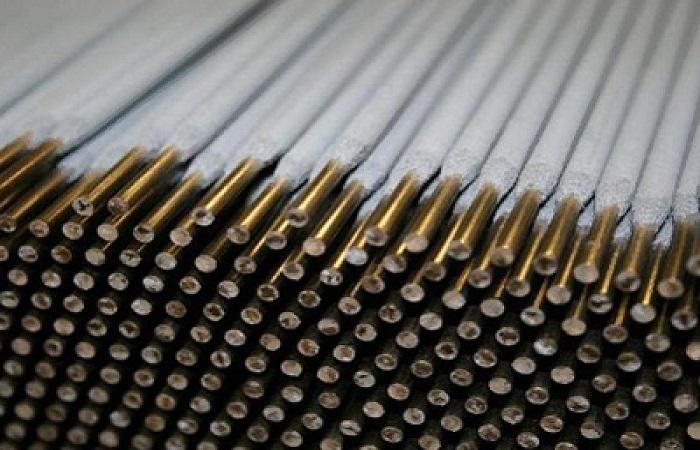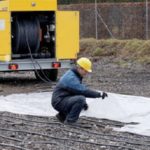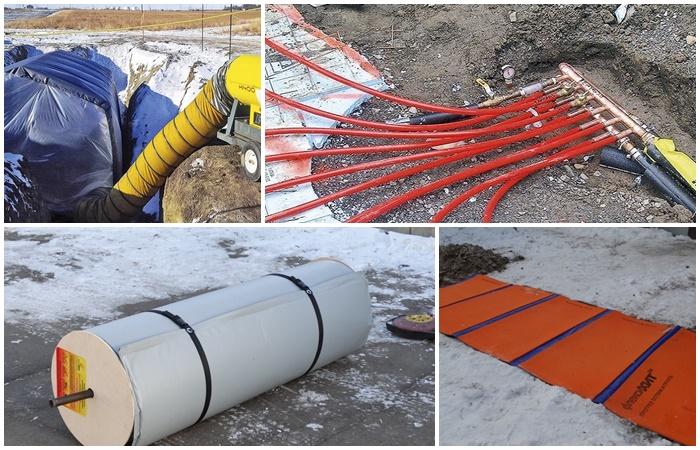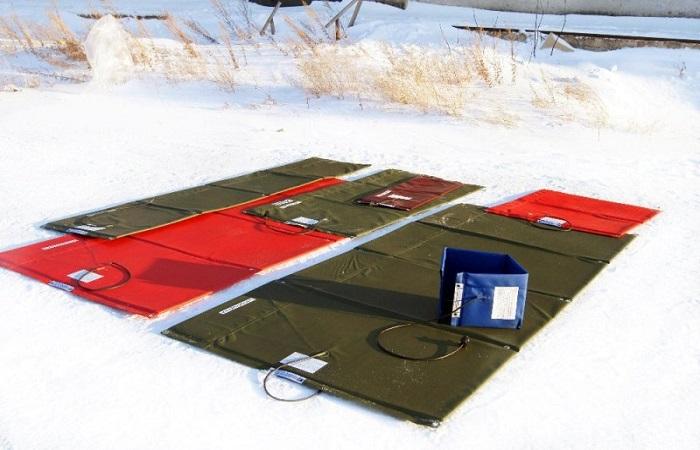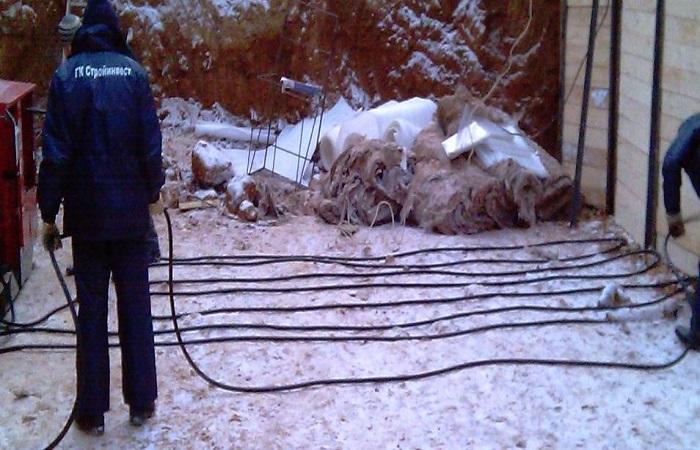Excavation work in winter causes a number of difficulties. One of the tasks that may arise is the need for preliminary preparation. The use of jackhammers or other types of mechanical impact is not always possible, since this provokes damage to underground communications or damage to buildings located nearby. Therefore, thermal technologies for heating the soil in winter are often used.
Traditional types of heating frozen soil
Today, many techniques are known that are based on different principles of temperature influence. They all have certain pros and cons.
Reflex oven
This is a fairly quick way to warm up the soil, which is convenient and perfect for use within the city. The heat generator in this case is nichrome wire, the thickness of which is 3.5 millimeters. The direction of thermal radiation is corrected by a reflector made of chrome plated sheet. Its thickness should be approximately 1 millimeter.
The reflector itself is insulated with a metal casing. There is an air cushion between the walls of 2 metals. It performs thermal protective functions. The stove operates from the mains and can heat 1.5 square meters of soil. To warm a cubic meter of soil, an amount of energy of approximately 50 kilowatts per hour is required. This takes 10 hours.
The main disadvantage of this method is considered to be the high risk of electric shock to third parties. Therefore, during the operation of the installation, it is necessary to install fences and provide security.
Also, the disadvantages of this method include the low coverage area and the need for an energy supply system with a capacity of about 20 kilowatts per hour to operate a complex that includes 3 installations.
Electrodes
This method of heating the soil can be implemented using various methods:
- To cultivate soil at a depth of less than 70 centimeters, it is necessary to use electrodes in the form of steel strips. Their edges must first be bent upward to connect the wires. The strips should be laid on the ground and sprinkled with a layer of sawdust. Their thickness should not exceed 20 centimeters. To increase conductivity, it is recommended to moisten sawdust with a low concentration salt solution.Then voltage needs to be applied to the strips.
- To heat the soil to a depth of more than 70 centimeters, it is recommended to use electrodes in the form of steel rods. They need to be driven into the soil in a checkerboard pattern at intervals of 0.5-1 meter from each other. Then you need to apply voltage to them, which will start the heating process. As the soil thaws, the rods should be driven in more and more.
In any case, the manipulation takes approximately 30 hours. At the same time, the energy consumption for processing 1 cubic meter of soil is about 60 kilowatts per hour. To implement this method, a power source is required. In addition, it is necessary to constantly monitor the process. Otherwise, there is a risk of electric shock to people.
Open flame
This method is based on the combustion of solid or liquid fuel in a special device, which consists of open tanks. The first box is the combustion chamber, and the last one is supplemented with an exhaust pipe.
Chemical method
To defrost the soil with chemical reagents, you need to drill holes in it. Then you need to pour sodium chloride into the holes to dissolve the ice. The process takes 6-8 days.
It does not require constant monitoring and is simple. However, the use of chemical reagents negatively affects the condition of the soil. It will not be possible to use it subsequently for growing cultivated plants.
Steam needles
Needles are special metal pipes. Their diameter is 25-50 millimeters, and their length is 1.5-2 meters. They have tips with holes with a diameter of 2-3 millimeters and are connected by flexible hoses to supply steam, the temperature of which exceeds 100 degrees.
It is recommended to place the needles in a checkerboard pattern. This should be done at intervals of 1-1.5 meters from each other. Devices must be installed in pre-drilled wells. Then, under a pressure of 0.07 megapascal, hot steam is supplied there. This method should be used if the depth of the future trench is 1.5 meters or more. This method helps warm the soil within a few hours.
The disadvantages of the method include the need to use a steam generator and the complexity of preparatory measures. In addition, during the procedure a lot of condensate is released - about 35 liters for every meter of surface treated. Another disadvantage is the need for constant monitoring of the process.
Hot coolant
In this case, the soil is heated under the influence of a hot mineral, the temperature of which is 100-200 degrees. They cover the entire surface of the earth. For this purpose, materials that remain after laying roads can be used. This could be concrete chips or damaged asphalt. The defrosting period is at least 20-30 hours.
However, this method also has some disadvantages. These include, in particular, dependence on a subcontractor, heat losses during the delivery of the coolant, and the need to clean up the coolant after the ground thaws. Another disadvantage is the long defrosting time.
Tubular electric heaters
When implementing this technology, thermal energy is transferred by contact method. Electric needles act as working elements. They are pipes 1 meter long and 50-60 millimeters in diameter. There are electric heating elements inside. They are placed horizontally and connected in series to the circuit.
This method also has certain disadvantages. These include the need for constant supervision and the risk of electric shock to people. Also considered disadvantages are the small thawing area and the need to carry out preparatory measures.
Heating the soil with thermoelectromatic devices
An excellent option for heating the soil is the use of thermomats. They help to uniformly heat the soil throughout its depth and help maintain the set temperature automatically.
Which method is better to choose?
Each method of soil heating has certain pros and cons. The simplest and least expensive method is to use hot sand. Ordinary quarry sand is used as the material for the procedure.
It is heated at the factory to a temperature of 180-250 degrees, after which it is delivered by vehicles to the desired location. To reduce heat loss, sand needs insulation. It takes about a day for the soil to warm up.Then the cooled coolant can be removed and subsequently used for other purposes.
On average, a cubic meter of such material is enough to impact an area of 4 square meters. The use of hot sand in the construction industry is considered one of the cheapest and most effective options.
Another great option is to use thermomats. This option has the following advantages:
- no risk of environmental pollution;
- complete safety for people;
- high efficiency;
- no need for preliminary preparation.
Warming up the soil can be done in different ways. Each of them has certain pros and cons. This allows you to choose the most suitable option.

